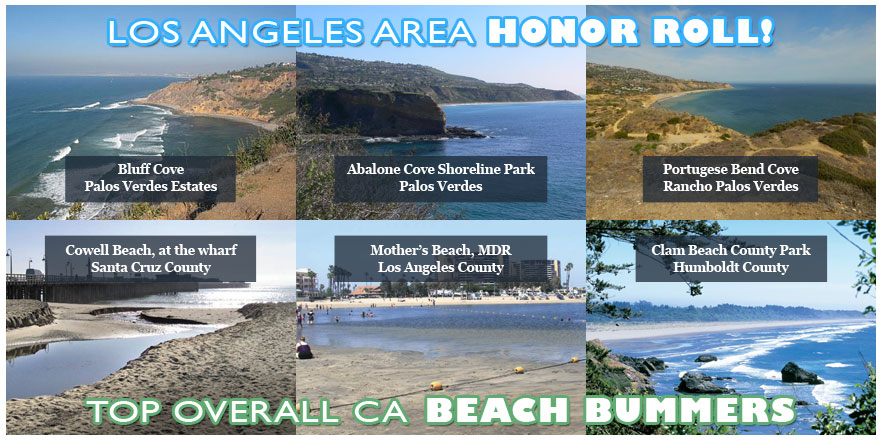BEACH REPORT CARD JUNE 17, 2015
School’s out for summer… but the grades are in for California’s beaches!
The Report
News Releases
Media Coverage
Californians heading to the shoreline this summer will be heartened by continued excellent water quality at beaches statewide, according our 25th annual Beach Report Card.
Heal the Bay analysts assigned A-to-F letter grades to 468 beaches along the California coast for three reporting periods in 2014-2015, based on levels of weekly bacterial pollution. Some 95% of beaches received A or B grades during the summer (April-October 2014). That figure is essentially steady with the last year’s report.
Overall, only 13 of the beaches monitored statewide received D to F grades during summer dry weather, when most beachgoers typically use the ocean. High bacteria counts at these sites are linked to potential illnesses like stomach flu, ear and upper respiratory infections and major skin rashes.
Southern California had excellent summer dry weather water quality with 97% A or B grades. Summer dry weather grades in the San Francisco Bay area (Marin County through San Mateo County) were also excellent with 93% (39 of 42) of ocean-side locations receiving A or B grades.
The severe drought now impacting California appears to be a major contributing factor to generally strong water quality at beaches statewide. With record low rainfall reducing the amount of polluted runoff funneled into our seas, beach grades across the state are consistently outperforming their five-year average.
Beach water quality grades may be higher in a given year due to less runoff, yet the resulting improved water quality may be providing a false sense of long-term beach water quality improvement. While low rainfall totals have led to significantly improved water quality statewide, it should be noted that California often swings from extended dry periods to shorter periods of intense, wet weather.
In response, Heal the Bay’s policy staff is advocating for a public funding measure to build infrastructure projects that capture, cleanse and reuse stormwater rather than dumping it uselessly into the sea. Progressive city planning, smart public infrastructure and so-called Low Impact Development in the private sector would turn a nuisance into a resource.
Nearly one in four monitored beaches in California received F grades for wet weather in the report, a figure that raises public health concerns for the state’s growing legion of year-round surfers, paddle-boarders and divers. The marked seasonal difference in water quality is why Heal the Bay recommends that ocean-users avoid the water for at least three days after a storm.
Heal the Bay’s annual Beach Bummer List, a ranking of the state’s 10 most polluted beaches, is evenly split among beaches in Southern and Northern California. Cowell Beach in Santa Cruz has the dubious distinction of topping the list for a second year in a row. New entrants this year include Mission Bay at Clairmont Drive in San Diego, Candlestick Point/Sunnydale Cove in San Francisco and Huntington State Beach at Brookhurst in Orange County.
This Year’s Top 10 Beach Bummers
- Cowell Beach – at the wharf (Santa Cruz County)
- Marina del Rey – Mother’s Beach (Los Angeles County)
- Clam Beach County Park (Humboldt County)
- Marina Lagoon (San Mateo County)
- Mission Bay at Clairmont Drive (San Diego County)
- Stillwater Cove (Monterey County)
- Candlestick Point/Sunnydale Cove (San Francisco County)
- Santa Monica Pier (Los Angeles County)
- Cabrillo Beach harborside (Los Angeles County
- Huntington State Beach at Brookhurst (Orange County)

It’s not all bad news. Some 19 beaches in the state were named to Heal the Bay’s Honor Roll, meaning they were monitored year-round and scored perfect A+ grades every week of the year, regardless of dry or rainy conditions.
Most of the California coastline earned A grades throughout the summer reporting period. Some 94% of L.A. County beaches received A or B summer grades, a 10% increase from the county’s five-year seasonal average. Beaches in Orange County earned summer grades of A or B at 99% of locations. San Diego County also scored very well, with 96% of it monitored sites earning A or B marks. However, both counties each placed one site on the overall Top 10 Beach Bummer List.
Moving up the coast, 100% beaches in Santa Barbara and Ventura counties earned A grades during the summer. Nearly nine in 10 San Luis Obispo County beaches notched A grades. Some 75% of Santa Cruz beaches scored A summer grades, but it also had two beaches receive F grades. Monterey County beaches, which had a few underperforming sites, earned 76% A or B marks in the summer.
Further north, 81% of San Mateo County beaches scored A grades, and were dragged down by two failing beaches during the summer reporting period. Some 78% of San Francisco locations received A or B grades for the summer in the report, slightly below its five-year summer average. Marin County and Sonoma counties each had 100% of beaches earn an A summer grade. Mendocino and Humboldt counties earned mixed grades.
A new model: ‘Nowcasting’ water quality
This summer Heal the Bay and Stanford University have implemented a pilot program at three beaches in Southern California to test the effectiveness of new predictive beach water-quality tools. Using sophisticated statistical models, the scientific teams are aiming to accurately predict water quality at historically troubled beaches.
Final results of pilot study are due this fall, but promising early results indicated that beach managers may be able to post a warning notice immediately at pollution-impacted beaches rather than waiting for bacteria testing, which can days to complete. These new models will protect public health by providing more timely and advanced water quality information.
Read the full report



